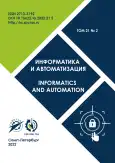卷 21, 编号 2 (2022)
Information security
Model Checking for Real-Time Attack Detection in Water Distribution Systems
摘要
Water distribution systems represents critical infrastructures. These architectures are really critical and an irregular behaviour can be reflected in human safety. As a matter of fact, an attacker obtaining the control of such of an architecture is able to perpetrate a plethora of damages, both to the infrastructure but also to people. In this paper, we propose an approach to identify irregular behaviours focused on water distribution systems. The designed approach considers formal verification environment. The logs retrieved from water distribution systems are parsed into a formal model and, by exploiting timed temporal logic, we characterize the behaviour of a water distribution system while an attack is happening. The evaluation, referred to a water distribution system, confirmed the effectiveness of the designed approach in the identification of three different irregular behaviours.
 219-242
219-242


Data Partitioning and Asynchronous Processing to Improve the Embedded Software Performance on Multicore Processors
摘要
Nowadays, ensuring information security is extremely inevitable and urgent. We are also witnessing the strong development of embedded systems, IoT. As a result, research to ensure information security for embedded software is being focused. However, studies on optimizing embedded software on multi-core processors to ensure information security and increase the performance of embedded software have not received much attention. The paper proposes and develops the embedded software performance improvement method on multi-core processors based on data partitioning and asynchronous processing. Data are used globally to be retrieved by any threads. The data are divided into different partitions, and the program is also installed according to the multi-threaded model. Each thread handles a partition of the divided data. The size of each data portion is proportional to the processing speed and the cache size of the core in the multi-core processor. Threads run in parallel and do not need synchronization, but it is necessary to share a general global variable to check the executing status of the system. Our research on embedded software is based on data security, so we have tested and assessed the method with several block ciphers like AES, DES, etc., on Raspberry PI3. The average performance improvement rate achieved was 59.09%.
 243-274
243-274


Comprehensive Defense System against Vulnerabilities Based on Return-Oriented Programming
摘要
 275-310
275-310


Mathematical modeling and applied mathematics
Identification of Deterioration caused by AHF, MADS or CE by RR and QT Data Classification
摘要
A sharp deterioration of the patient’s condition against the backdrop of the development of life-threatening arrhythmias with symptoms of acute heart failure (AHF), multiple organ dysfunction syndrome (MODS) or cerebral edema (CE) can lead to the death of the patient. Since the known methods of automated diagnostics currently cannot accurately and promptly determine that the patient is in a life-threatening condition leading to the fatal outcome caused by AHF, MODS or CE, there is a need to develop appropriate methods. One of the ways to identify predictors of such a state is to apply machine learning methods to the collected datasets. In this article, we consider using data analysis methods to test the hypothesis that there is a predictor of death risk assessment, which can be derived from the previously obtained values of the ECG intervals, which gives a statistically significant difference for the ECG of the two groups of patients: those who suffered deterioration leading to the fatal outcome caused be MODS, AHF or CE, and those with favorable outcome. A method for unifying ECG data was proposed, which allow, based on the sequence of RR and QT intervals, to the construct of a number that is a characteristic of the patient's heart condition. Based on this characteristic, the patients are classified into groups: the main (patients with fatal outcome) and control (patients with favorable outcome). The resulting classification method lays the potential for the development of methods for identifying the patient's health condition, which will automate the detection of its deterioration. The novelty of the result lies in the confirmation of the hypothesis stated above, as well as the proposed classification criteria that allow solving the urgent problem of an automatic detection of the deterioration of the patient's condition.
 311-338
311-338


Modeling the Dynamics of Collective Behavior in a Reflexive Game with an Arbitrary Number of Leaders
摘要
 339-375
339-375


Artificial intelligence, knowledge and data engineering
Fuzzy Logic Approaches in the Task of Object Edge Detection
摘要
 376-404
376-404


Crop Identification Using Radar Images
摘要
 405-426
405-426


Analysis of Multi-Temporal Multispectral Aerial Photography Data to Detect the Boundaries of Historical Anthropogenic Impact
摘要
 427-453
427-453











